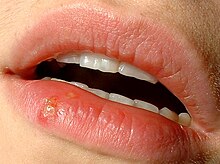Herpes simplex
Herpes simplex is an infection by a virus. The herpes simplex virus (HSV) causes two common diseases. Both diseases have painful, watery blisters in the skin or mucous membranes (such as the mouth or lips) or on the genitals.

An infection on the lips is commonly known as a cold sore or fever blister. A cold sore is not the same as a canker sore, which appears inside the mouth and is caused by something else.
Treatment change
The disease is contagious, especially when it is active. Contagious means that it can spread from one person to another. There is no cure for this disease. This means that it cannot be stopped, once a person has got it. When a person has got the disease, he or she will get outbreaks from time to time. There are drugs that can make these outbreaks shorter, for many people. These antiviral drugs stop the virus from spreading. They will shorten the time people show symptoms.
Different viruses change
The two types of herpes virus are known as simplex virus, type 1 (HSV-1) and type 2 (HSV-2).[1] HSV-1 usually causes infections around the mouth. HSV-2 more commonly causes genital infections.[2] Viruses are transmitted through body fluids, or lesions in the skin.[1] Transmission can also occur, when there are no symptoms.[1] Genital herpes is classified as a sexually transmitted infection.[1] It may be spread to a baby during childbirth.[1] Herpes outbreaks can occur, because of decreased immune function, stress, and sunlight exposure.[2][3]
How to tell that someone is infected change
Usually, herpes is diagnosed based on the symptoms.[2] There are tests that can confirm this diagnosis.[1] Testing the blood for antibodies against the virus can confirm a previous infection but will be negative in new infections.[1]
How common it is change
Herpes is very common. Worldwide rates of either HSV-1 or HSV-2 are between 60% and 95% in adults.[4] Most people get HSV-1 when they are children.[1] Since there is no cure for either HSV-1 or HSV-2, more people get it as they get older.[4] Rates of HSV-1 are between 70% and 80% in poorer people and 40% to 60% in richer people.[4] About 536 million people worldwide (16% of the population) were infected with HSV-2 as of 2003. It is more common among women and in developing countries.[5] Most people with HSV-2 do not know that they are infected.[1]
References change
- ↑ 1.0 1.1 1.2 1.3 1.4 1.5 1.6 1.7 1.8 "Genital Herpes – CDC Fact Sheet". cdc.gov. December 8, 2014. Archived from the original on 31 December 2014. Retrieved 31 December 2014.
- ↑ 2.0 2.1 2.2 Balasubramaniam, R; Kuperstein, AS; Stoopler, ET (April 2014). "Update on oral herpes virus infections". Dental Clinics of North America. 58 (2): 265–80. doi:10.1016/j.cden.2013.12.001. PMID 24655522.
- ↑ Elad S, Zadik Y, Hewson I, et al. (August 2010). "A systematic review of viral infections associated with oral involvement in cancer patients: a spotlight on Herpesviridea". Support Care Cancer. 18 (8): 993–1006. doi:10.1007/s00520-010-0900-3. PMID 20544224. S2CID 2969472.
- ↑ 4.0 4.1 4.2 Chayavichitsilp P, Buckwalter JV, Krakowski AC, Friedlander SF (April 2009). "Herpes simplex". Pediatr Rev. 30 (4): 119–29, quiz 130. doi:10.1542/pir.30-4-119. PMID 19339385. S2CID 34735917.
- ↑ Looker, KJ; Garnett, GP; Schmid, GP (October 2008). "An estimate of the global prevalence and incidence of herpes simplex virus type 2 infection". Bulletin of the World Health Organization. 86 (10): 805–12, A. doi:10.2471/blt.07.046128. PMC 2649511. PMID 18949218.